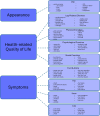Psychometric findings for LIMB-Q kids based on an international study of 800 children and adolescents with lower limb differences
- PMID: 40617908
- PMCID: PMC12228855
- DOI: 10.1186/s41687-025-00916-y
Psychometric findings for LIMB-Q kids based on an international study of 800 children and adolescents with lower limb differences
Abstract
Background: LIMB-Q Kids is a new patient-reported outcome measure (PROM) for children and adolescents with Lower limb differences (LLDs). This international field test study aimed to evaluate the psychometric properties of LIMB-Q Kids.
Methodology: Patients from pediatric orthopaedic clinics with a diagnosis of LLDs were recruited. Participants completed LIMB-Q Kids and 2 generic quality of life questionnaires, i.e., PROMIS Pediatric Short Form v2.0 - Mobility 8a, and PedsQL. Demographic and clinical data were collected including the LLRS AIM Index, a measure of clinical severity for LLDs. Rasch measurement theory (RMT) analysis was used to examine the psychometric properties of LIMB-Q Kids. Test-retest (TRT) reliability was examined and tests of construct validity were performed.
Results: Participants (N = 800) were recruited from 16 sites in 7 countries. Participants were aged 8 years and older (mean = 13, standard deviation = 3.2, range 8-25 years) and had a broad range of LLDs (e.g., Leg Length Discrepancy, Fibular Hemimelia, Skeletal Dysplasia, Blount's disease, Posteromedial Tibial Bowing, Osteogenesis Imperfecta, Congenital Pseudarthrosis of Tibia, Tibial Hemimelia and Amputations). RMT analysis provided evidence of the reliability and validity of 9 independently functioning scales that measure leg appearance, physical function, symptoms (hip, leg, knee, ankle, and foot), leg-related distress, and social, and psychological function. In addition, TRT reliability based on a sample of 46 participants was high for all 9 scales (Intraclass correlation coefficient ranges from 0.76-0.95). LIMB-Q Kids Physical Function scale correlated strongly with the PROMIS Pediatric Short Form v2.0 - Mobility 8a (Pearson correlation 0.82) and the PedsQL Physical Function total score (Pearson correlation 0.77). As hypothesized, participants with more severe LLDs based on the LLRS AIM index scores reported lower scores on all LIMB-Q Kids scales, indicating more impact on the patients.
Conclusions: This study provided evidence for the validity and reliability of LIMB-Q Kids. This new PROM can be used to inform research, quality improvement efforts, and clinical care. By measuring outcomes that matter most to children and adolescents with LLDs, LIMB-Q Kids can provide information to support evidence-based decisions.
Level of evidence: Level III.
Keywords: Health-related Quality of Life; International study; Limb deformities; Limb differences; Limb reconstruction; Patient-reported outcomes; Psychometrics; Quality of life.
© 2025. The Author(s).
Conflict of interest statement
Declarations. Ethics approval and consent to participate: Institutional ethics approval for this study was obtained from the senior author’s institution (H21-02204), and each participating site’s ethics review board. Data transfer agreements were signed with each participating site. Participants provided assent (written or verbal depending on the individual site’s research ethics guidelines) and parents provided written consent for the participation of their children. Consent for publication: N/A. Competing interests: McMaster University and the University of British Columbia hold the copyright of LIMB-Q Kids and its translations. Drs. Cooper, Chhina, and Klassen are co-developers of this PROM and may receive a share of any license revenue associated with its use by ‘for-profit’ organizations. Klassen is an owner of EVENTUM Research which provides consulting services to the pharmaceutical industry. Other coauthors have no competing interests to declare.
Figures
Similar articles
-
Development and Assessment of a Patient-Reported Outcome Instrument for Gender-Affirming Care.JAMA Netw Open. 2025 Apr 1;8(4):e254708. doi: 10.1001/jamanetworkopen.2025.4708. JAMA Netw Open. 2025. PMID: 40249619 Free PMC article.
-
A New Measure of Quantified Social Health Is Associated With Levels of Discomfort, Capability, and Mental and General Health Among Patients Seeking Musculoskeletal Specialty Care.Clin Orthop Relat Res. 2025 Apr 1;483(4):647-663. doi: 10.1097/CORR.0000000000003394. Epub 2025 Feb 5. Clin Orthop Relat Res. 2025. PMID: 39915110
-
Psychometric Properties of the Instrument for Scoring Clinical Outcomes of Research for Epidermolysis Bullosa patient score (iscorEB-p): a patient-reported outcome measure.Br J Dermatol. 2024 Jun 20;191(1):75-81. doi: 10.1093/bjd/ljae019. Br J Dermatol. 2024. PMID: 38261404
-
Physical exercise training interventions for children and young adults during and after treatment for childhood cancer.Cochrane Database Syst Rev. 2016 Mar 31;3(3):CD008796. doi: 10.1002/14651858.CD008796.pub3. Cochrane Database Syst Rev. 2016. PMID: 27030386 Free PMC article.
-
Education support services for improving school engagement and academic performance of children and adolescents with a chronic health condition.Cochrane Database Syst Rev. 2023 Feb 8;2(2):CD011538. doi: 10.1002/14651858.CD011538.pub2. Cochrane Database Syst Rev. 2023. PMID: 36752365 Free PMC article.
References
-
- Wilson GN (1998) Heritable limb deficiencies. In: JA H, Birch J editors. Rosemont, IL, American Academy of Orthopaedic Surgeons, pp 39–51
-
- Ramaker RR, Lagro SW, van Roermund PM, Sinnema G (2000) The psychological and social functioning of 14 children and 12 adolescents after Ilizarov leg lengthening. Acta Orthop Scand 71(1):55–59 - PubMed
-
- Kaufman KR, Miller LS, Sutherland DH (1996) Gait asymmetry in patients with limb-length inequality. J Pediatr Orthop 16(2):144–150 - PubMed
-
- Ghoneem HF, Wright JG, Cole WG, Rang M (1996) The Ilizarov Method for Correction of Complex Deformities. J Bone Jt Surgery Am 78:1480–1485 - PubMed
-
- McCarthy J, MacEwen G (2001) Management of leg length inequality. J South Orthop Assoc 10:73–85 - PubMed
Publication types
MeSH terms
LinkOut - more resources
Full Text Sources
Medical
Research Materials



